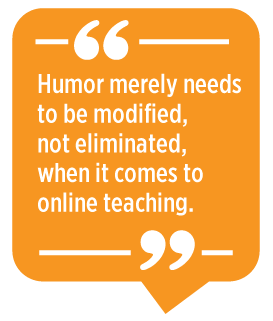|
 From the spring of 2020 until the summer of 2021, all of my
English classes were online. Even as I grew accustomed to this (for me)
completely new teaching format, I also realized an integral part of the
classroom experience was sorely missing: the sound of my students’ laughter. I
thus found myself sadly nodding my head (and I know I wasn’t alone) when
reading an
article by Henderson (2021) in which he discussed the negative impact
of online teaching on humor use. He argued that humor is more difficult to
incorporate in the online format because of, among other reasons, From the spring of 2020 until the summer of 2021, all of my
English classes were online. Even as I grew accustomed to this (for me)
completely new teaching format, I also realized an integral part of the
classroom experience was sorely missing: the sound of my students’ laughter. I
thus found myself sadly nodding my head (and I know I wasn’t alone) when
reading an
article by Henderson (2021) in which he discussed the negative impact
of online teaching on humor use. He argued that humor is more difficult to
incorporate in the online format because of, among other reasons,
- missed context cues,
- poor audio or video connections, and
- less contagious laughter.
In the classroom, humor is a powerful tool that
teachers can turn to in order to lighten the atmosphere, make speaking in the
target language less intimidating, and enhance the teaching of grammar or
vocabulary. Though the spontaneous joking that helps to improve the atmosphere
of traditional language classes is indeed much more challenging when you are
speaking into your computer and looking at video thumbnails (of webcams which
may or may not be on), it is not all bad news. Humor merely needs to be
modified, not eliminated, when it comes to online teaching. Additionally, there
are some advantages to the online format. The online teaching format can
provide
- a safe environment for experimenting with
humor,
- more time for learners to digest the humor,
and
- the opportunity to focus on the importance of how
humor is used online (e.g., on social media).
In the third (and final) part of this series on
humor in English language teaching (ELT), I introduce practical techniques that
illustrate these three potential advantages of humor in online teaching. (Read Part
1 on the benefits, misconceptions, and risks of using humor in ELT,
and Part
2 on classroom techniques.)
1. Online Teaching Provides a Safe Environment for
Experimenting With Humor
Pomerantz and Bell (2011) argued that “engagement
in spontaneous humorous performances can provide rich opportunities for
language use and development, beyond those habitually found in more tightly
controlled classrooms” (p. 157). Though I wholeheartedly embrace this approach,
many of my students still hesitate to engage in humorous interaction in the
classroom, either because they lack confidence or aren’t sure if the humor
lacks appropriateness.
When I assigned my students to prepare and share
prerecorded speaking videos for the class LMS in my online courses, I encouraged
them to relax and have fun. A very pleasant surprise was that students actually
incorporated humor into their speaking tasks more than in
the traditional classroom. I had a number of “this probably wouldn’t happen in
the regular classroom” moments. One of these occurred in a video presentation
in which students had to design a themed tour of Japan for international
tourists. One student chose natto (fermented soybeans
infamous for its gooey, stringy texture and strong odor; see Image 1) as the
focus of his tour. I have often advised my students that starting a
presentation with humor is a great way to get the attention of the audience.
Instead of yet another presentation starting with “My name is ____ and I will
talk about ____,” this student opened a fresh package of natto, then demonstrated the gooey texture as he stretched
the beans right up to the camera and explained the theme of his tour. He got my
attention!

Image 1. Natto.
The great thing about this student’s use of humor
is that it was contagious. Because they were mostly taking lessons from home,
other students started incorporating humorous props into their speaking videos.
As stressed in Part
1 of this series, humor should not only be teacher centered. Though
the teacher may encourage the use of humor, it is often much more effective
when it is learner initiated, as this inspires other students to include humor
in their own speaking tasks. The important thing to remember about humor,
however, is it should be used to enhance, and not replace,
learning. The natto student got an A on his assignment because
his humorous and attention-getting introduction was just one aspect of a
high-quality presentation.
Though we may lose the contagious laughter in
online teaching, classes like this one still featured a lot of (or even more!)
humor. Additionally, in self- and peer evaluations, students wrote comments
like, “Because I wasn’t in the classroom, it felt more natural to use humor”
and “Other students’ funny videos cheered me up during COVID-19.”
 2. Online Teaching Gives Learners More Time to Digest the
Humor 2. Online Teaching Gives Learners More Time to Digest the
Humor
Humor can be a double-edged sword in the classroom.
Some language instructors avoid using humor because they worry that it can be
both motivating and demotivating—students who understand the humor benefit, but
students who don’t understand the humor may lose confidence and feel
frustrated. It takes a lot of time to get humor in a foreign language, and it
should be a step-by-step process in the language teaching classroom.
One way to give learners more time to digest the
humor is to create online humor “quizzes” (e.g., on Google Forms). One type of
humor that works well with this approach is satirical news. As explained in Part
2 of this series, humor instruction works best when it has value
beyond just a laugh. A deeper understanding of English satirical news helps
multilingual language learners (MLLs) to improve their
- digital literacy (e.g., understand the types of
humor that are shared on social media),
- media literacy (e.g., differentiate between real
and “fake” news), and
- understanding of English-speaking cultures (e.g.,
get insights into how humor is used to critique contemporary issues).
You can create an out-of-class online quiz that
mixes satirical news headlines with real (but offbeat) news headlines. Students
complete a Likert-style survey in which they rank each item from 1 (definitely
satirical news) to 6 (definitely real news). Sample items I have used before
include the following:
-
Namco unveils potato chip-flavored cola (real
news: Sora
News 24)
-
Teen boasts of drunken driving on Facebook,
arrested (real news: CNET)
-
Study Reveals: Babies are Stupid (satirical
news: The Onion)
-
BREAKING NEWS: Husband Cooks for Wife (satirical
news: The
Rising Wasabi)
See the full
quiz, which I created in Google Forms for my students in Japan (answer key here). Doing
this humor quiz online takes away the pressure of having trouble understanding
this form of humor. Though students may need to enter their name, student
number, or alias to get credit for the assignment, their classmates cannot see
their answers.
Whether teaching face-to-face or online, you should
provide guidance to help learners better detect and comprehend satirical news.
Simple tips that can help to differentiate satirical news items from real news
items include
- rhetorical cues (e.g., not newsworthy, absurd
situations) and
- linguistic cues (e.g., informal style, more nouns
in the title).
After providing humor construction on detecting
satirical news, I highly recommend giving a second quiz featuring new items. In
previous research I did with Caleb Prichard (Prichard & Rucynski,
2019), students were able to significantly improve their ability to detect
satirical news after just one class period devoted to humor instruction.
3. Online Teaching Provides an Opportunity to Focus on
How Humor Is Used Online
As I have stressed in this three-part series, a
deeper understanding of the humor of the target culture(s) is an integral
component of cross-cultural communicative competence. However, this includes
both humor that takes place in face-to-face communication and online
communication. Social media and other Web 2.0 platforms provide countless free
opportunities for MLLs to develop their English language skills, but the frequent
use of humor by users can impede language learners’ ability to fully comprehend
some content.
In Part
2 of this series, I explained the importance of understanding verbal
irony in intercultural communication. However, detecting and comprehending
online ironic statements (e.g., sarcastic comments on social media or other
platforms) is equally important because
- irony is frequently used on such platforms,
- cues to normally detect irony are missing (e.g.,
verbal and nonverbal cues), and
- a lack of understanding of ironic statements can
lead to embarrassment or misunderstandings.
With regards to cues for detecting irony, we have all
likely had frustrating experiences when reading an email message or Facebook
comment and not being completely sure whether the other person is serious or
joking. Decoding whether written language is ironic or sincere is even more
challenging when reading in a foreign language.
As an introduction to helping learners detect true
intent, prepare easy examples with visual support and task learners with
differentiating between ironic and sincere comments. Again, learners can do the
activities anonymously using online tools such as Google Forms or a class LMS.
You can even use the same “model” for multiple examples, such as with my
family’s dog Ziva, shown here in Images 2 and 3:

Image 2. Good Ziva.

Image 3. Naughty Ziva.
Though verbal (e.g., exaggerated intonation, flat
tone) and nonverbal (e.g., winking, rolling eyes) cues are missing in online
ironic comments, different cues are available. In another study I conducted
with Prichard (Prichard & Rucynski, 2022), we shared some tips with
learners, including the following:
|
Cue |
|
/s =
sarcasm |
|
BiG aND sMalL
lEtTeRs = sarcasm |
|
Emoji and comment
do not match ("I love rainy days... ") = sarcasm ") = sarcasm |
|
Laughing emoji  or LOL does not always mean sarcasm.
or LOL does not always mean sarcasm. |
|
Stressing a word
(CAPS). ("I TOOOTALLY love natto.") = maybe
sarcasm |
|
If a person says
something very different than you expect = maybe sarcasm |
It is important to stress that some cues only sometimes mean irony or sarcasm. For example, the laughing
emoji could follow either an ironic comment or a humorous, sincere comment.
After the simple cues (e.g., /s = sarcasm, BiG aND sMalL lEtTeRs = sarcasm),
move on to more complex tasks like identifying incongruity, or detecting
comments in a social media thread that do not seem logical. Create fictional
threads (featuring either two or multiple commenters) and task learners with
identifying whether the final comment is ironic or sincere. Here is an example:
Thread 1
A: I have to take the TOEFL test this
weekend!
B: Don’t worry. I’m sure you’ll do great!
[ironic / sincere]
Thread 2
A: I have to take the TOEFL test this
weekend!
B: That sounds like a fun weekend. I envy you!
[ironic / sincere]
As any MLL can tell you, Thread 2 features the
ironic comment!
Again, designing this type of humor quiz online not
only exposes MLLs to the types of ironic online comments they may encounter,
but also provides an anonymous format to give learners the opportunity to
practice detecting humor without potential embarrassment. Having all student
answers on a platform such as Google Forms also makes it easy for you to track
which types of humor are more challenging for your learners.
Conclusion
Although this part of the series focused on online
teaching, these three advantages are important regardless of teaching format.
Whether you are teaching face-to-face or online, it is important to provide a
safe environment for learners to experiment with humor, give learners time to
digest humor, and include a focus on how humor is used both in face-to-face
communication and online. Though Henderson (2021) was certainly correct in
arguing that using humor in online teaching does have some obstacles, I also
agree with Anderson (2011) that using humor is still a way to “take the
distance out of distance education” (p. 80).
References
Anderson, D. G. (2011). Taking the “distance” out
of distance education: A humorous approach to online learning. Journal of Online Learning and Teaching, 7(1),
74–81.
Henderson, S. (2021, February 5). No
joke: Using humor in class is harder when learning is remote. The
Conversation. https://theconversation.com/no-joke-using-humor-in-class-is-harder-when-learning-is-remote-153818
Pomerantz, A., & Bell, N. D. (2011). Humor
as safe house in the foreign language classroom. The modern language
journal, 95, 148–161. https://doi.org/10.1111/j.1540-4781.2011.01274.x
Prichard, C., & Rucynski Jr., J. (2019).
Second language learners’ ability to detect satirical news and the effect of
humor competency training. TESOL Journal, 10(1), e00366.https://doi.org/10.1002/tesj.366
Prichard, C., & Rucynski, J.
(2022). L2 learners’ ability to recognize ironic online comments and the effect
of instruction. System, 102733. https://doi.org/10.1016/j.system.2022.102733
John
Rucynski has taught EFL/ESL in Japan,
Morocco, New Zealand, and the United States. He is currently associate
professor at Okayama University in Japan. His articles on humor in language
teaching have been published in English Teaching Forum, HUMOR, and TESOL Journal. He has also
edited New
Ways in Teaching with Humor (TESOL Press) and (with Caleb
Prichard) Bridging
the Humor Barrier: Humor Competency Training in English Language
Teaching (Rowman & Littlefield).
|